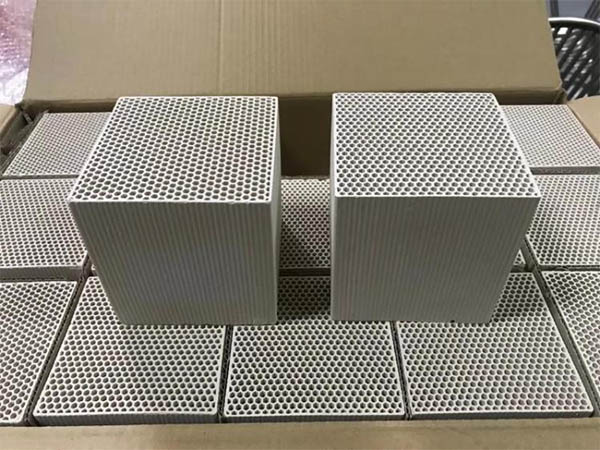
Zeolite molecular sieve Catalytic mechanism of
Molecular sieve generally refers to a kind of adsorbent that has uniform micropores and can selectively adsorb molecules with diameter smaller than its pore diameter. Such as zeolite molecular sieve, carbon molecular sieve, microporous glass molecular sieve, etc. The commonly used zeolite molecular sieve is crystalline aluminosilicate. Its general chemical formula is [M2 (Ⅰ) · M (Ⅱ)] O · Al2O3 · nSiO2 · mH2O, where M (Ⅰ) and M (Ⅱ) are 1-valent and 2-valent metal ions respectively, n is the silicon aluminum ratio, and m is the molecular number of crystal water. There are A-type, X-type, Y-type and other models, with the aperture between 3 and 10. Zeolite molecular sieve has large pores on the inner surface, which can absorb and store a large number of molecules, so the adsorption capacity is large; It is an ionic adsorbent with uniform pore size and strong adsorption selectivity; At higher temperature and lower partial pressure, it can still maintain strong adsorption capacity for some polar molecules. Widely used in drying, separation, etc. Zeolite molecular sieve is an inorganic crystal material, which is widely used in catalysis, adsorption, ion exchange and other fields due to its regular pore structure, strong acidity and high hydrothermal stability, and plays an irreplaceable role.
structure
Zeolite molecular sieve is the general name of a group of crystalline aluminosilicates. The basic structure of zeolite is composed of (SiO4) tetrahedron and (AlO4) tetrahedron. The adjacent tetrahedron is connected into a ring by an oxygen bridge. The rings are large and small. According to the number of oxygen atoms in the ring, there are four oxygen rings, five oxygen rings, six oxygen rings, eight oxygen rings, ten oxygen rings and twelve oxygen rings; The ring is the channel orifice of the molecular sieve, which plays a screening role on the molecular sieve passing through. The oxygen rings are connected with each other through the oxygen bridge to form a polyhedron with three-dimensional space. The polyhedron has a hollow cage, which is an important feature of molecular sieve structure. The cavity contains crystal water and cations, which are used to neutralize the negative charge of (AlO4) tetrahedron. Some or all of the crystal water can be easily removed by heating or decompression.
Catalytic mechanism
Zeolite molecular sieves can provide high activity and unusual selectivity in various acid catalytic reactions, and most reactions are caused by the acidity of molecular sieves. Acidity and its acid strength distribution are important parameters of molecular sieves. The research shows that the B acid in the molecular sieve comes from the skeleton tetrahedral aluminum, while the L acid mainly comes from the non skeleton hexahedral aluminum, so the content and distribution of Al in the molecular sieve are closely related to the surface acidic substances of the molecular sieve. Therefore, secondary hydrothermal treatment such as dealumination and aluminum supplementation of the molecular sieve can be used to obtain the molecular sieve with an ideal silicon aluminum ratio. In addition, the acidity of molecular sieves is also affected by substituted metal ions. The hydrolysis of multivalent metal ions leads to the redistribution of acid centers on the catalyst surface.
1. Sieving effect
It includes reactant shape selection and product shape selection. Shape selective catalysis of reactants has been applied in many aspects in oil refining industry, such as molecular sieve dewaxing of oil products, heavy oil hydrocracking, etc. Product shape selection has a significant effect on changing product distribution and improving the efficiency of target products, but there is also a harmful side. These undissolved macromolecules, or isomers with smaller linear degree, diffuse out, or break down into smaller molecules, or even do not
Broken cracking and dehydrogenation, deposited in the form of carbon in the pores and orifices, led to the deactivation of the catalyst.
2. Coulomb field effect
The ionic properties of the inner surface of the crystal and the electrostatic field interaction strength between the zeolite and the adsorbed molecules depend on the silicon aluminum ratio of the zeolite and the cation exchanged. The nano exchanged zeolite with low Si/Al ratio has a strong electrostatic field, while the hydrogen zeolite with high Si/Al ratio does not.
3. Configuration diffusion
This occurs when the structural size of the catalyst is close to the molecular size. In this diffusion mode, a small change in molecular size will cause a significant change in its diffusion coefficient.
4. Spatial adaptability or filtered selectivity
Some reactions can form corresponding transition state only because the inner diameter or the cage cavity has a large space, or they will be limited, making the reaction impossible. ZSM-5 catalyst is used for this transition state selective catalytic reaction.
5. Walkthrough control
Some zeolites (HZSM-5 molecular sieves) have cross channels with different channel sizes. Because small channels can only pass through small molecules, while large channels can pass through large and small molecules.
